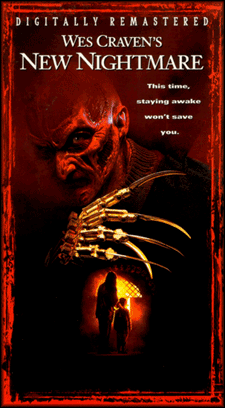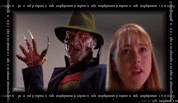


Heather is an
actress happily married, she has a little child: Dylan. She is worried
about a maniac who is calling frequently at her house and she thinks it
might be Freddy, the killer of her previous film. Meanwhile Wes Craven
is having some nightmares which inspire him to write the events in the
script for a New Nightmare series films. Heather is increasingly worried
by some murders in town and by the schizophrenia of her son. The only way
to save her son is to act for the last time the part of Nancy to defeat
Freddy forever.


Freddy was always
Wes Craven's baby. The Elm Street sequels, without the creator's
active involvement, veered increasingly farther away from his original
vision, and Freddy Krueger as we knew and loved him did die in the sixth
film. Evil never truly dies, though, a fact made clear by this remarkable,
visionary film. Only the most ingenious of scripts could bring Freddy back
to us in an acceptable way, and Wes Craven was the only man who could do
it. Hearkening all the way back to the fairy tales of old, we learn that
Freddy was only one incarnation of what could be called the ultimate evil.
Stories, so long as they are told, have the power to contain the forces
of evil; when Freddy was killed and the Nightmare series ended,
that evil was freed from its bonds and thus given the opportunity to cross
over to reality. The whole idea behind Wes Craven's New Nightmare is simply brilliant and ingenious, and it works fabulously on more levels
than I will have space enough to expound upon here.
Heather Langenkamp,
who played Nancy in the first and third films, plays herself in Wes
Craven's New Nightmare. She is joined by a myriad of cast members and
contributors to the original Elm Street film, including John Saxon
(who played Nancy's father), Robert Englund (whom everyone knows played
Freddy), Wes Craven himself, and a number of the men and women who worked
with Wes and New Line Cinema to bring Freddy to life in 1984. Craven is
working on a new script that will revive Freddy and pit him against his
old nemesis Nancy. The only problem is that fantasy is becoming fact for
Heather and her family, and the script begins to mirror real life in a
frightening way. Heather begins having horrible dreams of Freddy, and her
son Dylan (Miko Hughes) begins suffering from his own nightmares. As crazy
as it sounds, Heather is forced to conclude that Freddy Krueger is somehow
becoming real, and she will eventually have to reassume the role of Nancy
in an effort to stop him from passing through the final gate from fantasy
to reality.
Wes Craven's
New Nightmare is to me one of the greatest Freddy films of them all.
The idea of having cast and crew members of the original film serve as
Freddy's conduit to true existence works amazingly well. Langenkamp gives
a truly amazing performance in the highly personal role of herself, trying
to save her son and her very sanity from the evil she once defeated as
a character in a movie. Non-actors such as Wes Craven and New Line Cinema's
Bob Shaye play their parts very effectively, and the images of Robert Englund
that we see could not be in greater contrast to those of his character
Freddy. There are a number of direct references and haunting similarities
between the original film and this fresh and exciting new Freddy classic.
Not only should these delight the Freddy aficionado, they serve to make
the ultimate ending of this film believable and effective. Heather Langenkamp
has to become Nancy once again to stop Freddy, only this time the battle
is disturbingly real. Wes Craven's New Nightmare presents itself
as real life rather than cinema, making this the most innovative horror
sequel I have ever seen.
Some Freddy
fans don't care for this film, while others such as myself absolutely love
it. For some people, Freddy had become the witty, wise-cracking, over-the-top
killer of the later Elm Street sequels, and these fans want this type of
film to showcase Freddy doing his thing as many times as possible. To me,
that is not the true Freddy. A Nightmare on Elm Street's original
power was drawn from an incomprehensible foe that could kill you in your
dreams and scare the audience to death in the process. He was evil; he
just wanted revenge in the form of blood, guts, and terror, and he didn't
need to make a big production out of it. It is that Freddy who now haunts
Heather. This dark film may deliver far less of Freddy-ness in terms of
body count, dialogue, and on-camera minutes, but that only makes Freddy
all the more frightening and effective. Wes Craven's New Nightmare truly morphs the boundary between the real and unreal, delivering a level
of suspense and evil that all the earlier Elm Street sequels could
never hope to equal.
The DVD features
a long-desired extra in the form of commentary by Wes Craven himself. He
not only furnishes the reader with all sorts of fascinating trivia about
the film, he also captures the true essence of Freddy as a monstrous villain
and lends a philosophical appraisal of human nature and the archetype of
evil in society. I see this film as a defense of the horror genre itself,
one made abundantly clear in Craven's references to a career of anguish
with the MPAA and censors in particular. It is the very existence of horror
stories that allow evil to be contained in this world, and the eradication
of horror films in particular, something a number of people would love
to see happen, would truly let the genie out of the bottle and give free
rein to evil in the hearts of men. Wes Craven's New Nightmare captures
to a significant degree not only the attraction of horror but the absolute
necessity of it.
 | |  | | 
 | | 

- All of the earthquake sequences in the film were actually filmed one month prior to the Los Angeles quake of '94. The real quake struck only 2 weeks before the end of filming. Subsequently, a unit was sent out to film drive-by footage of actual quake damaged areas of the city before the end of filming. The cast and crew believed that the earthquake scenes that were filmed before the real quake struck were perhaps a bit overdone, but when viewed after the real quake hit, all were frightened by the realism of it.
- The "bio-engineered" hand/glove that Freddy uses in this film (as opposed to the glove used in the prior films) is actually derived from the artwork of the theatrical poster and video box covers of A Nightmare on Elm Street.
- Wes Craven's daughter Jessica Craven appears as a nurse.
- Heather is asked if she has a pass to which she replies, "Screw your pass." This is taken directly from A Nightmare on Elm Street.
- Lin Shaye, who appears as a nurse, also played the teacher in A Nightmare on Elm Street.
- The clothes worn by Heather Langenkamp and John Saxon towards the end of the film are the exact same clothes they wore in A Nightmare on Elm Street.
- The large rocket ship used in the park scene went into actor Miko Hughe's backyard after his father bought it.
- Before making New Nightmare, Wes Craven watched all of the Elm Street films. By the time he was finished, he claims that he could not follow the storyline at all.
- Director Wes Craven had intended to ask Johnny Depp to make an appearance as himself in the funeral scene. Craven never worked up the courage to ask him, but after the film's release, they ran into each other. Craven asked Depp if he would have made an appearance in the movie and Depp said that he would have, and that Craven should have asked him.
- The doorbell that the cops ring before telling Heather about her husband plays NBC's theme.
- The events in this film revolve around Heather Langekamp having a stalker. In real life she did have a stalker, and Wes Craven got her permission to weave it into the story
- A picture of Heather Langenkamp that was on John Saxon's desk in the original movie can be seen on a shelf in Wes Craven's house
- There was a scene in the script that depicted a Robert Englund Freddy nightmare. The nightmare had Robert stuck in a spider-like web and the new "DEMON" Freddy was a giant spider. This was dropped because it didn't fit with the film's overall tone.
- The book "The Nightmare Never Ends" by Andy Mangels can be seen on Bob Shaye's desk.
     


 |



















